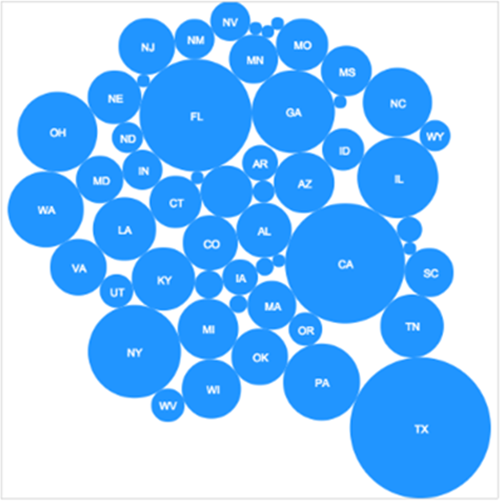 The U.S. Worker Fatality Database, an open access volunteer research effort, yesterday released new data about deaths on the job during the first seven months of 2015.
The U.S. Worker Fatality Database, an open access volunteer research effort, yesterday released new data about deaths on the job during the first seven months of 2015.
Using local, state and federal sources, as well as news media accounts, researchers have documented 1,073 deaths from traumatic on-the-job events during the first seven months of 2015. In 2014, the project identified more than 1,800 workplace deaths.
The new dataset includes:
A map of U.S. worker fatalities from January 1 through July 31, 2015;
A diagram of fatalities by state;
A table of fatalities by industry.
The volunteer effort, hosted at the website of the National Council for Occupational Safety and Health (National COSH), is the largest open-access data set of individual workplace fatalities ever collected in the United States. Two-thirds of the cases include names of the deceased workers.
Every death preventable
“The public has a critical need for information about the men and women who perish every day harvesting our food, building our homes, extracting our fuel and doing all the other jobs that move our economy,” said Bethany Boggess, research analyst at the Workers’ Defense Project and one of the founders of the U.S. Worker Fatality Database. “Every one of these deaths is preventable, but without timely knowledge of who is dying on the job and why, our prevention efforts will fall short.”
With data from 2015, the Worker Fatality Database has more identifying information about workers and the circumstances of their deaths and is more current than the Census of Fatal Occupational Injuries (CFOI), released annually by the U.S. Bureau of Labor Statistics (BLS). The most recent CFOI, released in April 2015, reports workplace deaths from calendar year 2013. It includes comprehensive aggregate and statistical data but does not have information on individual workers.
BLS data have shown more than 4,500 workplace deaths from traumatic events in each of the past five years. In addition, an estimated 50,000 workers die each year from long-term occupational hazards, such as exposure to toxic chemicals and other hazards.
Crushed, buried, fell
The U.S. Worker Fatality Database shows deaths so far in 2015 from 49 states as well as the District of Columbia, Puerto Rico and the U.S. Virgin Islands. Workers have died in 2015 when crushed by machinery, poisoned by carbon monoxide, falling from heights, buried by trench collapses, and from other causes.
“It’s incredibly frustrating because we know these deaths are preventable,” said Mary Vogel, executive director of National COSH. “We know how to prevent workers from falling off buildings. We know how to install proper ventilation, so workers are not poisoned to death. We know how to shore trenches so that workers are not buried in a trench collapse.”
Despite warnings that trench was unsafe...
One of the workers identified in the 2015 database is Carlos Moncayo, a 22-year-immigrant from Ecuador. He died on April 6th when a 13-foot deep trench he was working in collapsed at a New York City construction site. Inspectors had repeatedly warned contractors supervising the site that the trench was an imminent hazard because it was not properly shored up. Lacking support walls, the trench eventually did collapse. Moncayo was buried up to his neck and crushed to death by thousands of pounds of dirt.
On August 5th, Manhattan district attorney indicted two companies and two supervisors for causing Moncoya’s death. Harco Construction, Sky Materials, foreman Wilmer Cueva and site superintendent Alfonso Prestia were charged with manslaughter, negligent homicide and endangerment.
The indictment in Manhattan is one of several recent actions by prosecutors in response to workplace fatalities. On August 12th, the district attorney of Los Angeles announced a record $6 million fine against Bumble Bee Foods after Jose Melena, a 62-year old father of six, was burned to death inside one of the company’s industrial pressure cookers in 2012. It is believed to be the largest fine ever levied against a U.S. company for the death of an individual worker.
“You can’t put a price on a human life, and no amount of money can bring back a husband, a wife, a father or a mother,” said Jessica Martinez, Deputy Director of National COSH. “But seven-figure fines and indictments which can result in real prison time will get the attention of corporate executives.”
“To stay safe at work, workers must be able to organize and be empowered to know their rights,” said Martinez. “But when something goes wrong, we need to hold management accountable for their responsibility to provide a safe and healthy workplace.”
Groups participating in collecting information for the U.S. Worker Fatality Database include:
- National Council for Occupational Safety and Health (National COSH)
- AFL-CIO
- Beyond OSHA Project
- Center for Construction Research and Training
- Global Worker Watch
- Knox Area Worker Memorial Day Committee
- Massachusetts Coalition for Occupational Safety and Health (MassCOSH)
- Northeastern New York Coalition for Occupational Safety and Health (NENYCOSH)
- United Support and Memorial for Workplace Fatalities (USMWF)
- Workers Defense Project
Individuals and organizations can contribute information about fatal injuries to the U.S. Worker Fatality Database in English or in Spanish. Reports of fatal occupational illnesses can also be added in English or in Spanish.
National COSH links the efforts of local worker health and safety coalitions in communities across the United States, advocating for elimination of preventable hazards in the workplace. For more information, please visit coshnetwork.org.


